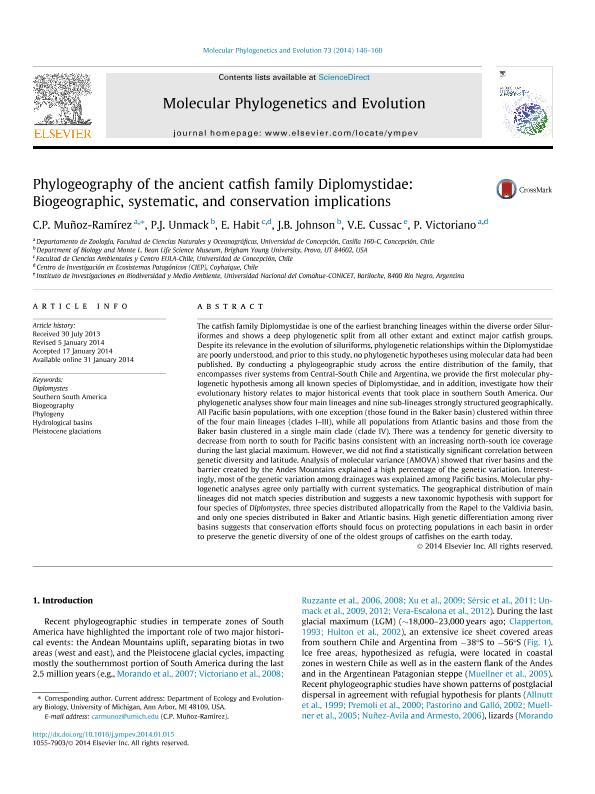Mostrar el registro sencillo del ítem
dc.contributor.author
Muñoz Ramirez, C. P.
dc.contributor.author
Unmack, P. J.
dc.contributor.author
Habit, E.
dc.contributor.author
Johnson, J. B.
dc.contributor.author
Cussac, Victor Enrique

dc.contributor.author
Victoriano, P.
dc.date.available
2016-12-19T22:05:22Z
dc.date.issued
2014-04
dc.identifier.citation
Muñoz Ramirez, C. P.; Unmack, P. J. ; Habit, E. ; Johnson, J. B.; Cussac, Victor Enrique; et al.; Phylogeography of the ancient catfish family Diplomystidae: biogeographic, systematic, and conservation implications; Academic Press Inc Elsevier Science; Molecular Phylogenetics and Evolution; 73; 4-2014; 146-160
dc.identifier.issn
1055-7903
dc.identifier.uri
http://hdl.handle.net/11336/9816
dc.description.abstract
The catfish family Diplomystidae is one of the earliest branching lineages within the diverse order Siluriformes and shows a deep phylogenetic split from all other extant and extinct major catfish groups. Despite its relevance in the evolution of siluriforms, phylogenetic relationships within the Diplomystidae are poorly understood, and prior to this study, no phylogenetic hypotheses using molecular data had been published. By conducting a phylogeographic study across the entire distribution of the family, that encompasses river systems from Central-South Chile and Argentina, we provide the first molecular phylogenetic hypothesis among all known species of Diplomystidae, and in addition, investigate how their evolutionary history relates to major historical events that took place in southern South America. Our phylogenetic analyses show four main lineages and nine sub-lineages strongly structured geographically. All Pacific basin populations, with one exception (those found in the Baker basin) clustered within three of the four main lineages (clades I–III), while all populations from Atlantic basins and those from the Baker basin clustered in a single main clade (clade IV). There was a tendency for genetic diversity to decrease from north to south for Pacific basins consistent with an increasing north-south ice coverage during the last glacial maximum. However, we did not find a statistically significant correlation between genetic diversity and latitude. Analysis of molecular variance (AMOVA) showed that river basins and the barrier created by the Andes Mountains explained a high percentage of the genetic variation. Interestingly, most of the genetic variation among drainages was explained among Pacific basins. Molecular phylogenetic analyses agree only partially with current systematics. The geographical distribution of main lineages did not match species distribution and suggests a new taxonomic hypothesis with support for four species of Diplomystes, three species distributed allopatrically from the Rapel to the Valdivia basin, and only one species distributed in Baker and Atlantic basins. High genetic differentiation among river basins suggests that conservation efforts should focus on protecting populations in each basin in order to preserve the genetic diversity of one of the oldest groups of catfishes on the earth today.
dc.format
application/pdf
dc.language.iso
eng
dc.publisher
Academic Press Inc Elsevier Science

dc.rights
info:eu-repo/semantics/openAccess
dc.rights.uri
https://creativecommons.org/licenses/by-nc-sa/2.5/ar/
dc.subject
Diplomystes
dc.subject
Southern South America
dc.subject
Biogreography
dc.subject
Phylogeny
dc.subject
Hydrological Basins
dc.subject
Pleistocene Glaciations
dc.subject.classification
Biología

dc.subject.classification
Ciencias Biológicas

dc.subject.classification
CIENCIAS NATURALES Y EXACTAS

dc.title
Phylogeography of the ancient catfish family Diplomystidae: biogeographic, systematic, and conservation implications
dc.type
info:eu-repo/semantics/article
dc.type
info:ar-repo/semantics/artículo
dc.type
info:eu-repo/semantics/publishedVersion
dc.date.updated
2016-12-12T14:35:44Z
dc.journal.volume
73
dc.journal.pagination
146-160
dc.journal.pais
Estados Unidos

dc.journal.ciudad
Ámsterdam
dc.description.fil
Fil: Muñoz Ramirez, C. P.. Universidad de Concepcion. Facultad de Cs Naturales y Oceanografia. Departamento de Zoologia; Chile
dc.description.fil
Fil: Unmack, P. J. . University Brigham Young; Estados Unidos
dc.description.fil
Fil: Habit, E. . Universidad de Concepción; Chile. Centro de Investigación en Ecosistemas Patagónicos; Chile
dc.description.fil
Fil: Johnson, J. B.. University Brigham Young; Estados Unidos
dc.description.fil
Fil: Cussac, Victor Enrique. Consejo Nacional de Investigaciones Científicas y Técnicas. Centro Científico Tecnológico Patagonia Norte. Instituto de Investigación En Biodiversidad y Medioambiente; Argentina
dc.description.fil
Fil: Victoriano, P. . Universidad de Concepcion. Facultad de Cs Naturales y Oceanografia. Departamento de Zoologia; Chile. Centro de Investigación en Ecosistemas Patagónicos; Chile
dc.journal.title
Molecular Phylogenetics and Evolution

dc.relation.alternativeid
info:eu-repo/semantics/altIdentifier/url/http://www.sciencedirect.com/science/article/pii/S1055790314000281
dc.relation.alternativeid
info:eu-repo/semantics/altIdentifier/doi/http://dx.doi.org/10.1016/j.ympev.2014.01.015
Archivos asociados
